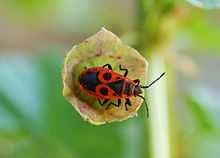Pyrrhocoridae
| Red bugs, cotton stainers | |
|---|---|
 | |
| Pyrrhocoris apterus (Spain) with reduced wings | |
| Scientific classification | |
| Kingdom: | Animalia |
| Phylum: | Arthropoda |
| Class: | Insecta |
| Order: | Hemiptera |
| Superfamily: | Pyrrhocoroidea |
| Family: | Pyrrhocoridae Dohrn, 1859 |
| Type genus | |
| Pyrrhocoris Fallen, 1814 | |
| Genera | |
|
See text | |
Pyrrhocoridae is a family of insects with more than 300 species world-wide. Many are red-coloured and are known as red bugs and some species are called cotton stainers because their feeding activities leave an indelible yellow-brownish stain on cotton crops. A common species in parts of Europe is the firebug, and its genus name Pyrrhocoris and the family name are derived from the Greek roots for fire "pyrrho-" and bug "coris". Members of this family can be quickly separated from the Lygaeidae by the lack of ocelli (simple eyes).
The membrane of the forewing has one or two cells from which about 7-8 branching veins emerge that may have branches that fuse together (anastomose) while the main veins reach the margins of the wing. They have three tarsal segments. They can be confused with some members of the family Largidae which also share some of these characters and belong to the same superfamily. Largidae tend to have the edge of the pronotum (the top of the first thoracic segment) rounded but the taxonomic feature for separating them is the found only in females. Female largids have the sixth visible (actually the seventh) abdominal segment appearing to be split in the middle whereas female pyrrhocorids have this undivided.[1] Bugs in the family Rhopalidae have similar colours but they have ocelli. The scutellum is small and triangular. The antennae are made up of four segments with the second segment longer than the third. The beak-like mouthpart or rostrum has four segments and tip reaches at least the base of the middle pair of legs. Some species have the wing reduced so that the abdomen is visible from above.[2] More detailed distinguishing features that are usually visible only under a microscope include a much reduced scent gland opening on the mid-thoracic segment. There are three sensory hairs or trichobothria on the abdominal segments 3 to 6 and two such hairs on the seventh segment.[3]
Most species feed on seeds or fruits particularly of plants belonging to the Malvales but a few feed on rotting debris including dead animal matter. A few species are predatory; Raxa nishidai is a predator of another pyrrhocorid, Melamphaus faber while Antilochus conqueberti feeds on other bugs including Dysdercus cingulatus.[4] A few are important crop pests. One species Dysdercus suturellus is well known in the southern cotton growing regions of the United States while Dysdercus cingulatus occurs on cotton in tropical Asia. They damage cotton bolls by staining as well as by cutting the fibres.[2][5]
The genus Myrmoplasta is found in the African and Oriental regions and is somewhat unique in having highly reduced wings and appearing ant-like or myrmecomorphic. Males and females differ in their foreleg morphology, but such sexual dimorphism is also found in a few other genera.[6]
Gallery
-

Dysdercus sp., India
-

Red cotton stainer bug, Kaeng Krachan National Park, Thailand
-
.jpg)
Red cotton stainer bug, Kaeng Krachan National Park, Thailand
-

Pyrrhocoris apterus on fruit of Malva sylvestris
Genera
There are numerous genera within the family and these include:[1][7]
- Abulfeda
- Aderrhis
- Aeschines
- Antilochus
- Armatillus
- Callibaphus
- Courtesius
- Cenaeus
- Delecampius
- Dermatinus
- Dindymus
- Dynamenais
- Dysdercus
- Ectatops
- Euscopus[8]
- Froeschnerocoris[9]
- Gromierus
- Indra
- Jourdainana
- Leptophthalmus
- Melamphaus
- Myrmoplasta
- Neodindymus
- Neoindra
- Probergrothius (Odontopus is preoccupied[1])
- Pyrrhocoris
- Pyrrhopeplus
- Raxa
- Roscius
- Saldoides
- Scantius
- Schmitziana
- Sericocoris
- Siango
- Sicnatus
- Stictaulax
- Syncrotus
References
- ↑ 1.0 1.1 1.2 Robertson, I.A.D. (2004). "The Pyrrhocoroidea (Hemiptera – Heteroptera) of the Ethiopian region". J. Insect Sci. 4: 14. doi:10.1093/jis/4.1.14. PMC 528874. PMID 15861230.
- ↑ 2.0 2.1 Borror, DJ; CA Triplehorn; NF Johnson (1989). An introduction to the study of insects (6 ed.). Philadelphia: Saunders College Publishing. p. 306.
- ↑ Schuh, RT and JA Slater (1995). True bugs of the World (Hemiptera:Heteroptera). Classification and Natural History. Ithaca: Cornell University Press. pp. 268–271.
- ↑ Schaefer, Carl W. (1999). "Review of Raxa (Hemiptera: Pyrrhocoridae)". Annals of the Entomological Society of America 92 (1): 14–19. doi:10.1093/aesa/92.1.14.
- ↑ L. Mata; J.M. Grosso-Silva; M. Goula (2013). "Pyrrhocoridae from the Iberian Peninsula (Hemiptera: Heteroptera)". Heteropterus Revista de Entomologia 13 (2): 175–189.
- ↑ Stehlik, Jaroslav L. (2007). "On the Afrotropical species of Myrmoplasta (Heteroptera: Pyrrhocoridae)". Acta Entomologica Musei Nationalis Pragae 47: 93–108.
- ↑ Hussey, RF. (1929). General catalogue of the Hemiptera. Fascicle III. Pyrrhocoridae. Northampton, Mass.: Smith College.
- ↑ Schaefer, Carl. W.; Ahmad, Imtiaz (2002). "A review of the Asian genus Euscopus (Hemiptera: Pyrrhocoridae)". Oriental Insects 36 (1): 211–220. doi:10.1080/00305316.2002.10417331.
- ↑ Ahmad, Imtiaz; Kamaluddin, Syed (1986). "Froeschnerocoris denticapsulus, a New Genus and New Species of Pyrrhocoridae (Heteroptera: Pyrrhocoroidea) from the Oriental Region". Journal of the New York Entomological Society 94 (2): 291–295.
External links
- Dysdercus suturellus, cotton stainer on the UF / IFAS Featured Creatures Web site
- Illustrated key to Pyrrhocoroidea
![]() Media related to Pyrrhocoridae at Wikimedia Commons
Media related to Pyrrhocoridae at Wikimedia Commons
![]() Data related to Pyrrhocoridae at Wikispecies
Data related to Pyrrhocoridae at Wikispecies